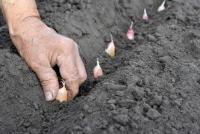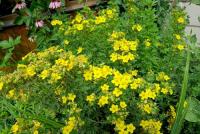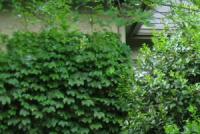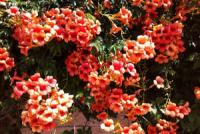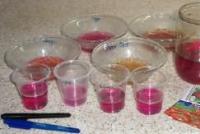Bush wolfberry blooms white fragrant clusters. Poisonous berries, fruits and plants found in the forests of Russia
Poisoning by toxic plants on the territory of the Russian Federation is very common. Children who eat attractive, juicy, but very dangerous fruits are most susceptible to intoxication. Everyone should be able to distinguish poisonous berries from edible ones.
Symptoms of intoxication
The poisonous berries of Russia can be found in forests, on the banks of rivers, lawns. Experienced foresters know that you can only collect the fruits that are familiar to them. It is better not to touch unfamiliar varieties, as well as suspicious-looking berries: they can cause not only severe poisoning, but also death within a few days.
Some poisonous berries in the forest can cause the intoxication of children when they consume 2-3 fruits. Adults need 15-20.
 Dangerous is also the juice of the bushes, which, once on the skin, can provoke irritation, redness, itching and blisters.
Dangerous is also the juice of the bushes, which, once on the skin, can provoke irritation, redness, itching and blisters.
Common symptoms that indicate poisoning are:
- jerking limbs;
- heart rhythm disorder;
- labored breathing.
Despite the harmless appearance, many poisonous berries cause severe body damage and can cause death.
Precautionary measures
Do not collect and taste unknown fruits. Having come to the forest with a small child, it is necessary to control which plants he eats, and also not to let him go alone.
If the area is not familiar, before you visit it, you need to inquire, ask the local population or read the special literature to find out what edible and poisonous berries are peculiar to it.
To avoid intoxication, only ripe berries should be harvested; green parts of the plant should be avoided when preparing dishes. or do not eat them at all. In addition, you should not use the little-known berry crops during pregnancy, during lactation, as well as children under 14 years.
Most often, poisoning by plants whose fruits are poisonous occurs because of their obscurity.
First aid
If characteristic symptoms such as fever, indigestion, diarrhea, or emetic urging occur within a few hours after ingestion, convulsions should be urgently referred to a medical institution.
 First aid measures include:
First aid measures include:
- Summon gag reflexes. This way you can free the digestive system from the contents. To do this, drink 400-800 g of lightly salted water and put pressure on the root of the tongue.
- Effectively flush the stomach can solution of water with potassium permanganate or activated carbon. Take coal in a high dose - 2 tablespoons per 500 g of water. After 20 minutes, provoke vomiting. The procedure should be repeated several times.
- Flush the intestinal system will help enema.
- Sorbents can help with medications: activated carbon, enterosgel, polysorb, as well as laxative preparations, for example, magnesium sulfate. If necessary, give the victim heart drops. If convulsive syndromes are observed, chloral hydrate is used.
The patient must be reassured, provide him with warmth, wait for the medical staff, or take him to a medical facility.
Most often, such measures can help cope with poisoning. However, if it concerns children, then medical assistance is vital: the children's body is more difficult to cope with intoxication. Poisonous fruits of plants can provoke serious consequences, including a negative impact on the psyche.
This dangerous plant has become widespread in all parts of Russia. There are many varieties of shrubs, the most toxic is four leaf, growing in deciduous and mixed forests.
These poisonous berries have a single flower, a fruit at the top of the stem, four large leaves, a long stem that contain poison that acts on the brain.
Toxic is the whole bush, including leaflets and root system.
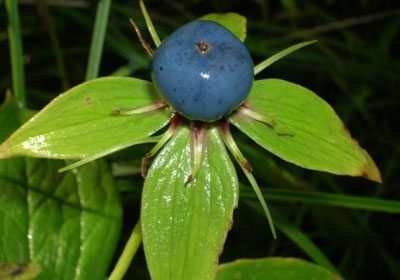 The bush berry is very beautiful: black, shiny, resembles the eye of a crow. However, the bush is very dangerous, it can provoke convulsive syndromes, a disorder of the heart, as well as fatal outcome. Having eaten the root of a crow's eye, you can cause severe vomiting, as well as cardiac arrest.
The bush berry is very beautiful: black, shiny, resembles the eye of a crow. However, the bush is very dangerous, it can provoke convulsive syndromes, a disorder of the heart, as well as fatal outcome. Having eaten the root of a crow's eye, you can cause severe vomiting, as well as cardiac arrest.
- burning in the mouth;
- tickling in the throat;
- pain in the stomach;
- diarrhea;
- nausea;
- emetic urge;
- dizziness;
- pain in the head;
- dilated pupils;
- abdominal cramps;
- heart failure, cardiac arrest;
- convulsive seizures.
Toxic substances contained in the shrub, provoke inflammation of the mucous surfaces of the mouth, nose, esophagus, and the digestive tract. In some difficult cases, paralysis of the respiratory system, respiratory failure.
Voronove is often used in alternative medicine as a laxative and emetic, as well as for the external treatment of wounds.
Is Voronove an edible berry or not? The most toxic are the berries: if you eat 2 berries, the child may die. It is impossible to accidentally poison the fruits: they taste very bitter and smell bad.
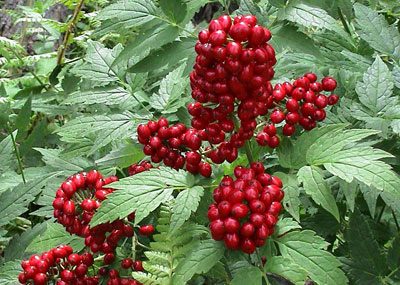 Of the poisonous varieties of the plant can be noted krasnoplodny and black spiky Voronets.
Of the poisonous varieties of the plant can be noted krasnoplodny and black spiky Voronets.
Krasnoplodny - perennial shrub with a thin stem, grows in the European part of Russia. Long oval fruits during ripening replace the green color with white, then become reddish.
The spike-shaped shrub has black fruits, it became widespread in Western Siberia, as well as in Europe.
Signs of poisoning are:
- weakness;
- dizziness;
- increased heart rate;
- indigestion in the form of diarrhea, gag reflexes, nausea.
Evergreen bush, reaching a length of 1.5 meters. In spring, it blooms with light pink or white flowers, which are closer to the autumn become fruits with a stone. Superficially resembles barberry. You can meet these poisonous plants in the forest.
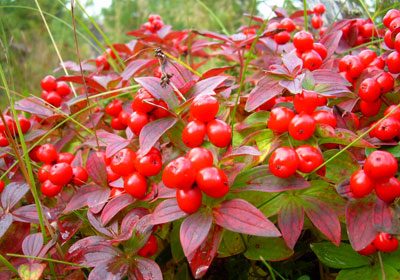 All parts of wolf bast are considered toxic.. A particular threat is represented by berries, the use of which in an amount of more than 5 pieces can trigger a lethal outcome.
All parts of wolf bast are considered toxic.. A particular threat is represented by berries, the use of which in an amount of more than 5 pieces can trigger a lethal outcome.
If swallowed, juice may cause burning and blistering. In contact with the skin, poisonous berries provoke bleeding. If shrub juice gets into the eyes, a corneal ulcer may occur.
Signs of intoxication wolf bast are:
- the appearance of emetic urge, nausea;
- stomach cramps;
- prostration;
- profuse salivation;
- loss of consciousness;
- burning sensation in the mouth.
The symptoms of intoxication wolf bast reminds gastroenteritis.
In severe cases, poisoning can lead to cardiac arrest.
Lily of the valley
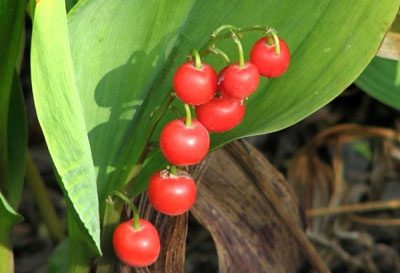 Perennial bush with light flowers in the form of bells. In late spring - early autumn, poisonous red berries appear on the stems, which predators feed on. You can meet lily of the valley in damp dark places, floodplain forests.
Perennial bush with light flowers in the form of bells. In late spring - early autumn, poisonous red berries appear on the stems, which predators feed on. You can meet lily of the valley in damp dark places, floodplain forests.
The whole plant is poisonous, berries - especially. Despite the fact that various medications used in the treatment of heart diseases are made from lily of the valley, it is easy to poison berries, especially in childhood.
In case of poisoning the patient has pain and noise in the head, constriction of the pupils, slowing the pulse. Some feel jerking legs and arms.
Elder
Elder stinky belongs to the family of honeysuckle. A small plant, reaching 3 m, has small red fruits, inside of which is a stone. The berries and leaves contain the greatest amount of toxins..
Shrub smells unpleasant, has a thick root, large leaves, blooms in late spring. It grows in the mountains, forests and lawns.
Particularly dangerous are unripe fruits.
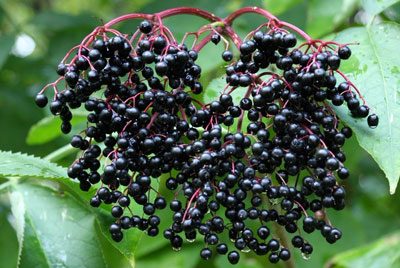 Poisonous berries can cause poisoning, manifesting symptoms:
Poisonous berries can cause poisoning, manifesting symptoms:
- sore throat;
- lethargy;
- abdominal cramps;
- dizziness;
- stomach upset.
The use of a plant can provoke cyanosis of extremities, a failure of the heart rhythm, its quickening and slowing down, shortness of breath, seizures. Elderberry is often the cause of death from heart failure.
Belladonna
A different name for the plant is demoiselle. Belongs to extremely dangerous shrubs.. The most toxic are fruits.
Perennial shrub up to 2 m has a green or purple stem, flowers of dark purple hue. Shrub blossoms from early summer to late fall. The berries are belladonna bluish-black, round-shaped, the taste is sweet-sour. Shrubs are widespread in the Crimea, in the Caucasus, on the edge of forests, shaded by glades.
Children are most often poisoned by the plant, taking the berries for grapes. Fruits contain alkaloids, which can cause severe poisoning, occurring after 10-20 minutes. In addition, honey from the flowers of belladonna is poisonous.
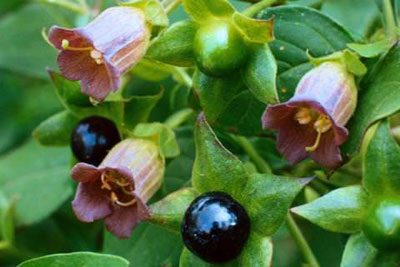 Dangerous berries can provoke intoxication with characteristic signs:
Dangerous berries can provoke intoxication with characteristic signs:
- the dryness of the mucous surfaces of the mouth and nose;
- hoarseness;
- dilated pupils;
- blurred vision;
- pain in the head;
- delirium;
- hallucinations;
- vomiting, nausea;
- difficulty urinating;
- diarrhea;
- dryness and redness of the skin;
- heart rhythm and breathing disorder.
In some severe cases, there is a strong nervous overexcitement, increased motor activity, loss of consciousness, coma, asthma, respiratory failure, heart failure, paralysis. Of the complications of poisoning can be noted swelling of the face, swelling of the shoulders and legs.
Buckthorn
Some parts of the shrub are often used for medical purposes as a laxative. Buckthorn berries grow singly, become purple-black when ripe, sweet to the taste.
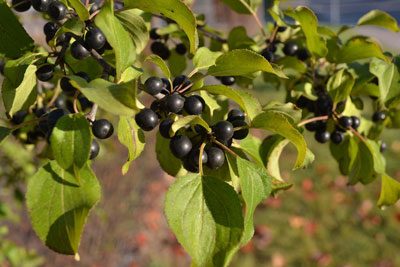 When using unripe fruits, severe intoxication can be provoked.. Poisoning is accompanied by the following symptoms:
When using unripe fruits, severe intoxication can be provoked.. Poisoning is accompanied by the following symptoms:
- intense vomiting;
- nausea;
- stomach cramps;
- profuse diarrhea, accompanied by pain in the rectum;
- urine excretion in blood.
The most frequently poisoned children are those who also have severe headache, heart rhythm disturbances, and convulsive twitching of the extremities.
To provoke death, enough 7-8 berries.
Often these poisonous wild berries grow in the neighborhood of alder. Plant blooms from late spring to September. The fruits of the bush most often regale bears and birds. Buckthorn bark is used in medicine: a decoction based on it is used for spasms, colitis, chronic constipation, as well as for the normalization of bowel function. Buckthorn juice is used to produce yellow and green dye, tanned leather.
Most often, the plant is grown as an ornamental. The graceful-looking shrub has round berries of white color, ripening to the beginning of autumn, pinkish flowers turning into fruits, which include saponin, which is very toxic to mucous surfaces and skin.
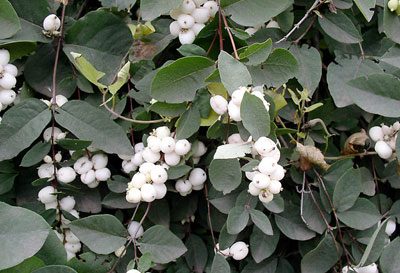 When eating poisonous berries cause:
When eating poisonous berries cause:
- prostration;
- gag reflexes;
- diarrhea;
- irritation of the digestive system;
- stomach cramps;
- dizziness;
- clouding of consciousness;
- fainting.
Getting on the skin, juice can provoke inflammation, irritation, redness, swelling, pain.
The snowberry is extremely dangerous for children.
There is a shrub on the coast of water. Purple flowers are similar to the colors of other solanaceous. It blooms from late spring to early fall. The nightshade has elongated red berries of a bittersweet taste, resembling tomatoes, ripening in summer.
The plant is considered medicinal and is often used in homeopathy and alternative medicine, but the leaves and berries may contain the poison glycoside dulcamarine, which causes a disorder of the brain and heart, breathing difficulties.
 Shrub can be found in the European part of the Russian Federation, Siberia and the Far East, it grows near water bodies and other wet places.
Shrub can be found in the European part of the Russian Federation, Siberia and the Far East, it grows near water bodies and other wet places.
Signs of intoxication are:
- digestive disorders;
- difficulty breathing;
- deterioration of the heart;
- suppression of nervous activity and ability to move;
- abdominal cramps.
Of the dangerous and toxic plants can also be noted arum spotted, calla, euonymus, honeysuckle.
To avoid unpleasant consequences, it is necessary to carefully collect the little-known and suspicious-looking berry crops and not allow children to them.
It's no secret that our forests are rich in various gifts of nature - these are mushrooms and, of course, berries. However, lovers of wild berries should remember that not all of them are useful and safe, and some of them can cause severe food poisoning and even cause death. Therefore, before going to the forest for mushrooms, berries, let's get acquainted with those forest "beauties", which should not be collected. Let them not a lot, but the poisonous berries need to know. And it is especially important that children know them well! So, forest poisonous berries ...
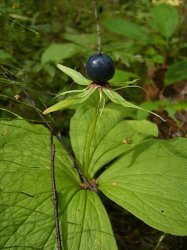 Raven eye (Rav quadrifolia L.) - A perennial plant of a very characteristic species. A short stalk framed in a sprawling, usually four (rarely, as in the photo, five) wide leaves, ends with a single nondescript greenish flower that blooms in July and June. Then the crow's eye turns the flower into one berry, blackening to autumn. The crow's eye is also known under the name of cross-grass, ranarn, bear berries, raven grass, raven berries, ravens.
Raven eye (Rav quadrifolia L.) - A perennial plant of a very characteristic species. A short stalk framed in a sprawling, usually four (rarely, as in the photo, five) wide leaves, ends with a single nondescript greenish flower that blooms in July and June. Then the crow's eye turns the flower into one berry, blackening to autumn. The crow's eye is also known under the name of cross-grass, ranarn, bear berries, raven grass, raven berries, ravens.
The plant is monocotyledonous, it is currently attributed to the melantia family (formerly referred to as liliaceae). There are several types of raven eyes. The most common of them is the four-leaf crow eye.
Crow's eye spread.
A crow's eye grows in shady, wet areas of coniferous, deciduous and mixed forests throughout Russia’s temperate zone from Europe to the Far East. Crow's eye is considered a medicinal plant, but it is better not to assemble and use it alone, as a crow's eye is a poisonous plant.
It is an ordinary inhabitant of deciduous and mixed coniferous-deciduous forests. It occurs very often. The appearance of the plant is peculiar, it is practically impossible to confuse it with another. The muddy arrangement of the leaves, a single flower, and then the fruit, which alone is located on top of the stem.
Toxic all plant - and the leaves, and rhizome. But especially poisonous berries of the crow's eye. Large, black, shiny, it really looks like a crow's eye. And very attractive, especially for children. But the crow's eye berry is deadly!
Poisonous Raven Eye parts.
Crow's berry, like other parts of the plant, is poisonous. The plant contains saponins and cardiac glycosides.
Symptoms of poisoning with a black eye.
Poisoning with poisonous berries or other parts of the crow's eye causes irritation of the gastrointestinal tract, diarrhea, nausea, vomiting, a sharp drop in heart rate to 60-40 or less contractions per minute, heart rhythm disturbances, ventricular flutter and cardiac arrest.
Substance paristifin from the group of saponins causes convulsions, disrupts the work of the heart, until it stops. In case of poisoning, it is necessary to flush the stomach from the poisons present. Namely, to give a poisoned person a piece of ice, let him hold it in his mouth (this is like an antidote). Inside you need to enter anesthesin and any drug that will restore the heart, for example, strophanthin.
In folk medicine, there are a number of recipes using the crow's eye to treat certain diseases. However, you need to know:
Because of its extreme danger the use of the crow's eye for any medical purposes is prohibited!
Out of curiosity, “children” can eat. In case of poisoning, urgent medical attention is required! Children from an early age should be introduced to this plant and explained that in no case should it be touched.
Daphne. (Daphne)
Very beautiful in the spring, the wolf's bark is very attractive in August, when its large red berries ripen. However, the whole plant - and the leaves, and bark, and fruit - poisonous!
 Daphne, daphne (Wolf's Face) - a low shrub is commonly called a wolf's bast or a wolfman. In April, the branches of Daphne are a meter and a half tall, almost entirely covered with bunches of bright pink flowers, very similar to the color of lilacs. From flowering plants spread a gentle peculiar aroma. Daphne leaves are narrow, dark green. Poisonous berries - oval, first green, then red, ripen in late July-August.
Daphne, daphne (Wolf's Face) - a low shrub is commonly called a wolf's bast or a wolfman. In April, the branches of Daphne are a meter and a half tall, almost entirely covered with bunches of bright pink flowers, very similar to the color of lilacs. From flowering plants spread a gentle peculiar aroma. Daphne leaves are narrow, dark green. Poisonous berries - oval, first green, then red, ripen in late July-August.
Spread of the wolfberry.
The wolves grow in the north of the European part of Russia, in Western and Eastern Siberia, in the Caucasus. Prefers coniferous and mixed forests. It is found in deciduous forests.
The poisonous parts of the wolfhorn.
Daphne flowers are poisonous. Inhalation of daphne pollen is observed irritation of the mucous membranes of the nose and respiratory tract. Not only flowers are poisonous, but the whole plant. No wonder one of the names of Daphne - wolf cub deadly.
The bark of the wolf's bark is unusually bitter in taste and, if it gets into the mouth, causes a burning sensation and scratching. Subsequently, blisters and ulcers form on the mucous membranes. The touch of the wet bark of daphne, wolfgrass to the skin can lead to the formation of ulcers.
No less stinging juice in the leaves and poisonous berries wolf bast. Extremely dangerous to get juice wolfman's eyes. It threatens with the formation of difficult-to-corneal ulcerations.
Symptoms of Wolf Bite Poisoning.
After eating poisonous berries, there is a burning sensation in the mouth, pain in the stomach, nausea, vomiting, weakness, and convulsions are possible. But the wolf's bast contains not only mezerein, which is very irritating to the skin and mucous membranes, but also other poisonous substances, in particular, several types of coumarins that cause increased bleeding.
It should not even be picked up to avoid skin burns. Moreover, taste the berries. The result will be severe damage to the gastrointestinal tract.
Wolfberry is a medicinal plant. It is widely used folk medicine. Yes, and the modern pharmacopoeia is interested in this plant! But this does not mean that they must be “interested” by nature lovers (only through a camera!). And all the more children should be warned about the danger of wolf bastard!
May lily of the valley.
May lily of the valley (Convallaria majalis) - the only representative of the genus of lily of the family Liliaceae.
Lily of the valley is widespread in the northern hemisphere, but especially in Europe. However, due to the unreasonable fees, the natural habitats of this beautiful plant are constantly being reduced. However, the lily of the valley has long been a garden plant.
It is a perennial with a thin creeping rhizome. There are several leaves in the basal rosette, but the lower ones are very small and inconspicuous, similar to scales. But two large broadly lanceolate leaves with arc venation are hard not to notice (and mixed up with the leaves of another plant). Between the leaves grows a flowering stem bearing a brush of delicate fragrant flowers.
Lily of the valley - not only a great decorative, but also a recognized medicinal plant. Recognized as not only folk, but also official medicine. Lily of the valley preparations treat the cardiovascular system. The main active ingredients are glycosides konvalitoksin, konvallotoksol, konvallozid. Get them from the leaves and flowers of the plant.
Symptoms of Lily of the valley poisoning.
The whole plant of the lily of the valley is poisonous. Lily of the valley berries are especially poisonous. Beautiful red berries are poisonous and they can not be plucked and even more so to eat. The most characteristic signs of poisoning by poisonous lily-of-the-valley berries are headache, tinnitus, a rare pulse, constriction of the pupils. Seizures are possible.
You can get poisoned and just out of curiosity - try the beautiful red berries! By the way, collecting large lily-of-the-valley bouquets in the spring, putting them in a room in a vase is also not worth it - a large amount of substances released into the air is not safe for health.
 Voronets spiky (Actaea spicata).
Voronets spiky (Actaea spicata).
Spiky Voronets (Voronet Voronoplodny) is a perennial herb of the ranunculus family. Cone-shaped Voronet is a perennial poisonous herbaceous plant up to 80 cm high, with a thin branched stem, with large, on long petioles, twice and triply pinnate leaves. The edges of the leaves are large-toothed.
The flowers are white or cream, small, gathered in a fluffy panicle.
The berries are first green, when ripe, black, glossy, large, oval-cylindrical with a clearly visible perianth trail. Berries are collected in a brush.
The spread of Voronitsa spiky black.
Voronove spiky black grows in the European part of Russia, in the Caucasus, in Western Siberia, in the Altai, but is quite rare. Prefers shady wet places in deciduous, coniferous and mixed forests. Usually grows in thickets of bushes and trees. Voronove spiky black does not like open spaces. The area of the black-headed crow is almost all of Europe, the south of the forest zone of Western Siberia and Altai. It blooms in May and June, the berries ripen in July and August.
Poisonous parts of the Voronitsa spiky.
The whole plant is very poisonous! Especially poisonous berries of black spiky black. After all, its organs contain a whole set of alkaloids and trans-acetic acid.
Symptoms of poisoning Voronove spiky.
The sap of the plant is irritating to the human skin, up to the formation of blisters. And even a small amount of poisonous berry pulp is enough to cause a strong disorder of the gastrointestinal tract.
True, the plant itself warns of its danger. Its smell is very unpleasant!
Like many poisonous plants, the black-headed crow is used in traditional medicine. Medicine official does not recognize him!
From the black fruit of the crown received a black dye for dyeing wool.
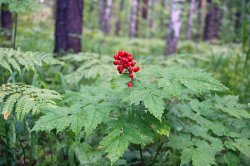 A close relative of the black-headed crow - voronets krasnoplodny (Actaea rubra).
A close relative of the black-headed crow - voronets krasnoplodny (Actaea rubra).
Voronove krasnoplodny (red; spiky red) is a perennial herb. Stems thin, up to 70 cm.
The leaves are usually pinnate, jagged at the edges. The appearance of the black coronet Voronet is very similar to the black crowed, but differs from it primarily in the color of the fruit, a few smaller berries, as well as in the lighter color of the leaves.
The flowers are small, white, gathered in a vertical brush-whisk.
The berries of the black-headed coronus are uvlodenno-oval, medium-sized, green at first, whiten as they ripen and then turn red. Located on a vertical brush.
The spread of the black coronet.
But if that is the inhabitant of Europe, and in Siberia it is already becoming rare, then the red-crowned Voronet widely populates the forest zone in the Far East, in Eastern and Western Siberia. Occurs in the north of the European part.
Voronet Krasnoplodny grows in coniferous and mixed forests in the Far East, in Siberia and in the north of the European part of Russia.
In appearance it looks like a relative, differing primarily in the color of the fruit - they are red.
The poisonous parts of the Red Voronitsa.
All parts of the plant are poisonous. The most toxic are the berries of the black Voronet. Eating only two poisonous berries for a child can end in tragedy. But the accidental poisoning of the berries of the black coronet is hardly possible, because the plant has an unpleasant smell, and the berries are very bitter.
Symptoms of poisoning.
Symptoms of poisoning with the berries of black coronet - nausea, dizziness, increased heart rate, severe upset gastrointestinal tract.
Too strong plant! A large number of alkaloids contained in all organs of the plant, make it potentially dangerous for a curious berry lover!
Although this Voronets also “nobly” warns of a smell about itself that is so characteristic that it received the name “stinker”.
The plant is widely used in traditional medicine. However, remember:
Need to be treated by specialists! Self-medication is dangerous because it can very easily go into its direct opposite. And such a “treatment” with poisonous plants is especially dangerous!
The fruits of the black cohosh have also been used to produce black dye. Hence, by the way, and the name. After all, "black" - just means "black."
Project language:
Here you will learn what berries can not be eaten.
Our country is very big, and there are many different berries in it. They are not only useful, but also poisonous. We will tell only about some of the most poisonous berries.
Its flowers are similar to the flowers of other solanaceous, especially potatoes. Oblong red berries are very reminiscent of small tomatoes.
The plant is a medicinal plant, very widely used in traditional medicine and homeopathy. However, the leaves and berries of the nightshade are poisonous! They should be treated by a specialist!
Eat berries (for the sake of curiosity), too, should not. The glycoside contained in them, dulcamarine, acts like atropine, causing disturbances in the central nervous system, respiration and heart function.
In addition to very poisonous berries, carrying a great danger even when they are accidentally consumed, there are berries in our forests ... not that poisonous, but simply inedible. Severe poisoning in their use will not. But trouble is almost certainly assured!
Buckthorn breaking
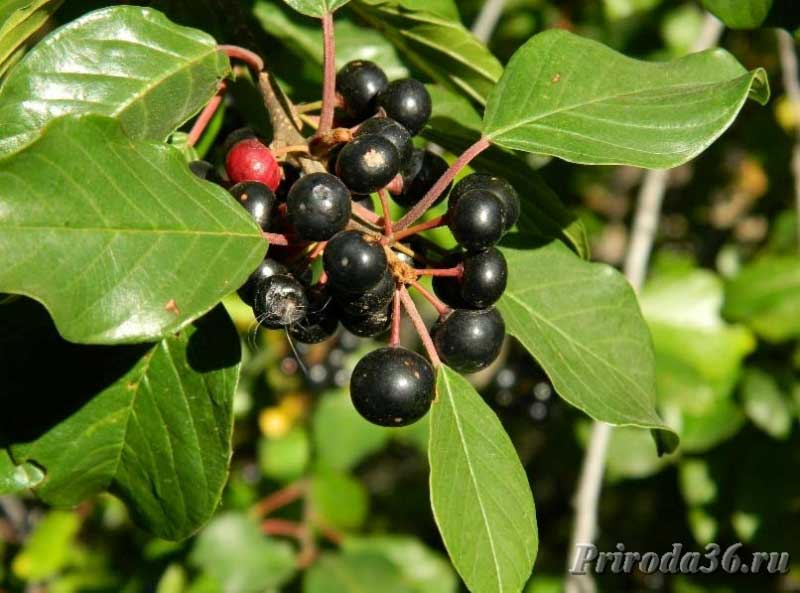
family rushinovye. In a rarefied forest, near rivers and lakes, streams, you can often find buckthorn buckthorn. This shrub from the family rushinovyh, very interesting. Hopefully, another article will be devoted to him. For now - only brief information about this medicinal plant with inedible fruits.
To hold out in the wild without food supplies until help arrives or you yourself reach some locality, you can, if you go to pasture. From spring to autumn to find it in the forest is not difficult. But no matter how appetizing the gifts of nature may seem, everything is by no means impossible. Having studied the assortment of wild berries, we chose those of them, which, if at all, could be fortified by food poisoning, at worst - it would all end in death.
Nightshade bitter
Semishrub blooms from late May to September. In June and October, the fruits of the nightshade, which are red berries, ripen. They, like the stem and leaves, are poisonous. Even the animals do not eat sweet and bitter berries. Its plants contain solanine glycoalkaloids, solidulcin, dulcamarine and other toxic substances that can cause poisoning. It manifests itself in the form of abdominal pain, nausea, vomiting, difficulty breathing and cardiovascular failure.
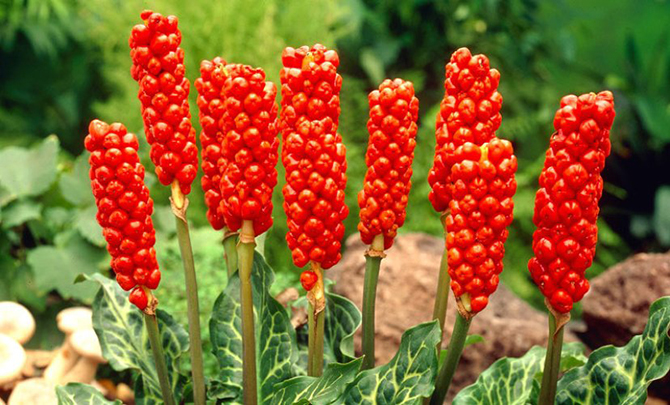
Arum
In August, leaves of perennial grass with a height of about 10-20 cm fall off, leaving a bare stem, the top of which is covered with red berries. Due to the content of alkaloids, it is not possible to eat them fresh. But if they are dried, the berries lose their poisonous properties and become completely edible.
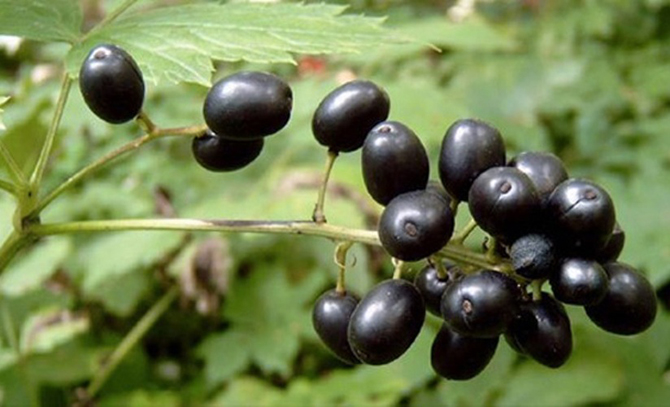
Voronets spiky
They may seem edible, if only because their birds peck. But this impression is deceptive, and for a person, unlike birds, they are dangerous. None of the organs of the plant is suitable for eating, let alone black berries ripening by mid-late summer. They are the most poisonous and contain substances that damage the nervous system and even in small quantities cause severe gastrointestinal upset. In addition, the plant juice, which when burned on the skin, burns, also has toxic properties.
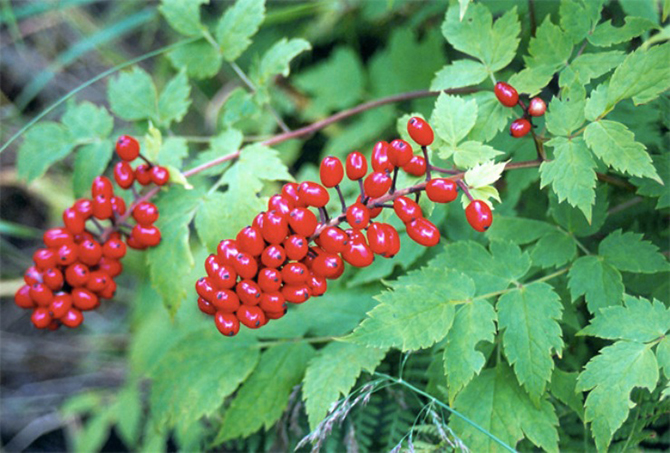
Voronove krasnoplodny
In appearance, it is similar to the crowed spider and can be distinguished only by the lighter color of the leaves and the color of the berries. They ripen by early September. The fact that the plant is inedible, says even its unpleasant smell. The berries themselves are very bitter and, if someone decides to satisfy their hunger, they will get dizziness, nausea, rapid pulse and severe upset stomach.

Wolfberry or wolf's bast
This low shrub with narrow leaves is not as harmless as it seems. Bark, leaves, flowers, fruits - they are all poisonous. Pollen of flowers leads to irritation of the mucous membranes of the respiratory tract. Sap plants, hitting the skin, causing ulcers and dermatitis. Dare to try the berries, which ripen in August-September, provided a burning sensation in the mouth, nausea, vomiting, possible convulsions and increased bleeding.
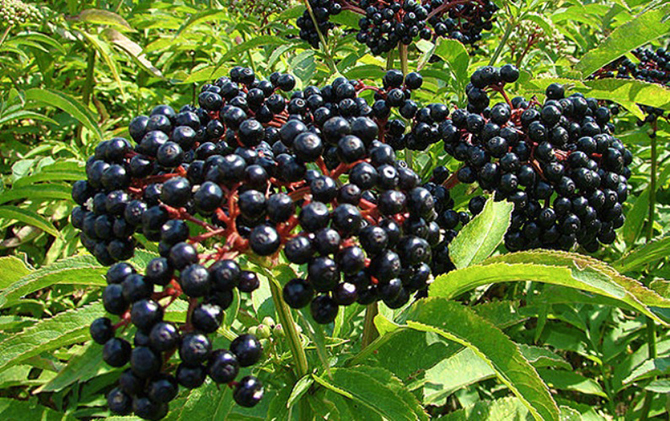
Elderberry
In August-September, black fruit ripen from the herbaceous perennial. It is believed that only unripe berries are toxic. In case of poisoning they cause sore throat, abdominal pain, nausea, vomiting, seizures are possible. Due to the accumulation of oxyhemoglobin in the venous blood, the mucous membrane of the oral cavity turns blue. Death comes from respiratory arrest on the background of acute heart failure. Ripe fruits are edible: they are made into wine, jam, and they simply eat them raw.

Warty euonymus
Warty euonymus refers to poisonous plants. You can not even eat the leaves, not like the fruit. Sweet berries, ripening in the second half of August, cause vomiting, diarrhea, chills and cramps, as well as impaired cardiac activity.

Raven eye
Berry, blackened by autumn, has a similarity with blueberries. But unlike it contains saponins and cardiac glycosides, which can cause irritation of the gastrointestinal tract, diarrhea, nausea, vomiting, a sharp drop in heart rate to 60-40 or less contractions per minute, and even cardiac arrest.
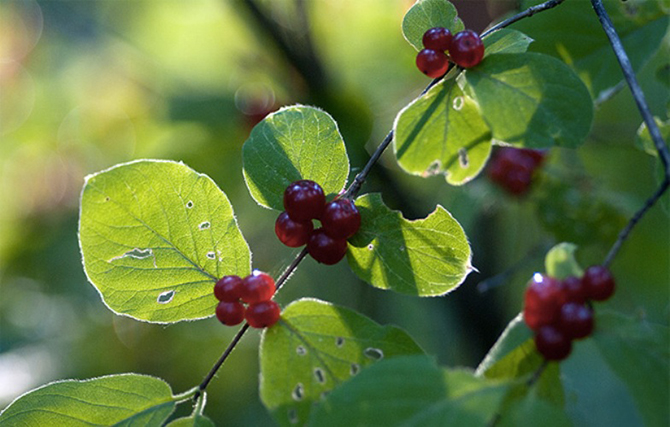
Poisonous berries can not only cause poisoning, but also lead to death. Therefore, it is extremely important to know what the poisonous berries of Russia look like. Before going to the forest, view pictures of poisonous berries, so as not to be mistaken. You can take a photo with you, then the poisonous berries will definitely be identified. Be sure to tell the children about the poisonous wild berries, explain that you can not eat in the forest, what kind of poisonous plants to watch out for. Show them pictures or photos of poisonous berries. Poisoning with poisonous berries can be very difficult, it is important not to eat unfamiliar fruits, no matter how seductively they look. Very often red berries and black berries are poisonous. Our short identifier of poisonous berries will help you avoid trouble.
| Belladonna Bog marsh Euonymus Privet Elderberry Lily of the valley |
Daphne Black Voronet Voronove red Raven eye Nightshade bitter First aid in poisoning with poisonous berries |
Nightshade bitter (red)
Nightshade bitter - shrub with curly long stem (up to 2 m, and in favorable conditions, and more), with a woody base.
Leaves - ovate-pointed.
The flowers are purple, with drooping racemes.
It blooms from late May to September.
Fruits - red bittersweet poisonous berries, ripen in June - October.
Nightshade Spread
Red nightshade is widespread in the European part of Russia, in the Caucasus, in Siberia and the Far East along the banks of reservoirs, in damp places, among bushes. Often found in settlements, on the outskirts of villages, at the inter-garden gardens, on the garbage heaps. Often, bitter sweet nightshade is grown in home gardens as a decorative liana.
The nightshade poisonous parts
The leaves, stem and fruits are poisonous to nightshade. As ripening, the poisonous properties of the bitter-sweet nightshade berries, unlike black nightshade, do not disappear, since in addition to the poisonous glycoalkaloid solanine, which disappears when the berries ripen, there are also other toxic substances, in particular solidulcin and dulcarmarin.
Symptoms of poisoning
Symptoms of bitter sweet poisoning are the same as in other plants containing solanine and similar glycoalkaloids - abdominal pain, nausea, vomiting, depression of motor and mental activity, difficulty breathing, cardiovascular failure. First aid - gastric lavage.

Poisonous berries picture, photo - red nightshade
Belladonna
Also known under the names of the demoiselle, krasuha, sleepy stupor, rabid berry, mad cherry (Atropa belladonna) is a plant of the solanaceous family. Perennial herbaceous plant with a height of 1-2 m. With upright thick green or purple-colored stem, at the top fork-like branching.
Leaves petiolate, broadly lanceolate, alternate, but pairwise approximated, and always one is much larger than the others.
The flowers of the belladonna are solitary, drooping, coming out of the sinuses of the upper leaves, bell-shaped, of a dirty-violet (sometimes yellow) color.
It blooms from June to late autumn.
The fruit is a brilliant black-and-blue poisonous berry, flattened-spherical, juicy, sweet-sour, the size of a cherry.
Belladonna Spread
Belladonna is widespread in the Crimea, in the Caucasus, in the Carpathians. Occurs in clearings, forest edges, shady meadows.
Belladonna poisonous parts
All parts of the plant are poisonous. Poisoning more often occurs in children who are attracted to poisonous belladonna berries resembling a cherry or grape (even 2-3 berries can cause severe poisoning in a child). In them, as well as in other parts of the plant, they contain such very poisonous alkaloids as atropine, hyoscyamine, scopolamine, etc.
Symptoms of poisoning
Signs of poisoning appear after 10-20 minutes. In the case of mild poisoning, dryness and burning in the mouth and throat, difficulty swallowing and speech, palpitations. The voice becomes hoarse. Pupils dilated, do not respond to light. Disturbed near vision. Photophobia, flashing flies before his eyes. Dryness and redness of the skin. Excitement, sometimes delirium and hallucinations. In severe poisoning, a complete loss of orientation, a sharp motor and mental agitation, sometimes convulsions.
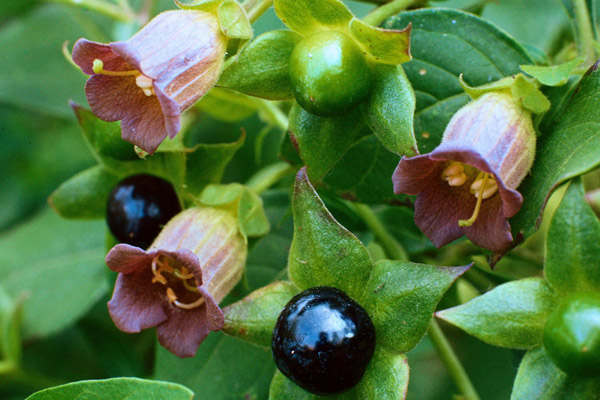
Poisonous berries picture, photo - belladonna
Calla calla
The marsh calla is a juicy, thickroot, creeping hydrophyte (plant, half growing in water) 20-40 cm high with large shiny round-heart-shaped leaves (15-20 cm) on long petioles. The comatous inflorescence is surrounded by white (green on the reverse side), leaf-like bedspread.
Fruits - juicy red poisonous berries collected in clusters.
It blooms in May, June, the fruits ripen from the end of June.
Calla Proliferation
The calf bog is widespread across the territory of Russia on bogs and marshy banks of reservoirs.
Poisonous Calla Bottles
All plant is poisonous, especially poisonous berries and rhizomes. Calla contains acutely saponin-like compounds, as well as volatile substances such as aroin with irritating properties.
Symptoms of Calla Poisoning
Nausea, vomiting, drooling, diarrhea, shortness of breath, tachycardia, convulsions. First aid - gastric lavage and laxatives.
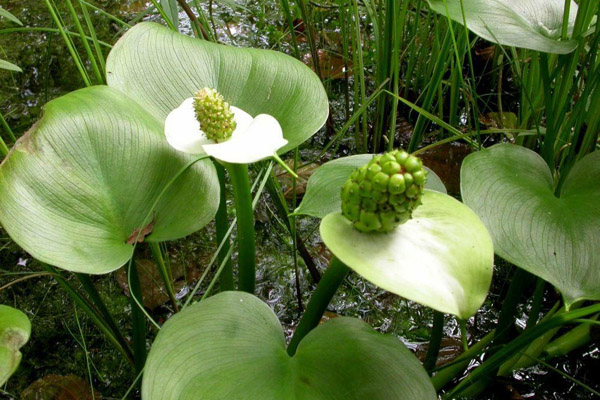
Poisonous berries picture, photo - marsh calla
Euonymus
Euonymus is a deciduous shrub (sometimes a small tree) 3-4 meters tall, with “classic” elongated leaves, greenish small nondescript flowers.
Euonymus blooms in May and June. The fruits fully ripen in September-October.
Fruits are beautiful bright pink four-part boxes, containing usually black seeds, covered with (sometimes not completely) fleshy orange or red flesh. As the ripening boxes open.
Distribution of Euonymus
Euonymus is found in the European part of Russia, in the Caucasus, some species grow in the Far East (to Eastern Siberia), Sakhalin, the Kuril Islands.
Poisonous parts of Euonymus
The euonymus has all its roots, bark, leaves, but the most dangerous are poisonous berries, which attract with their bright appearance.
Symptoms of poisoning by Euonymus
The use of poisonous berries of euonymus in food causes vomiting and diarrhea, large doses of berries can cause intestinal bleeding.
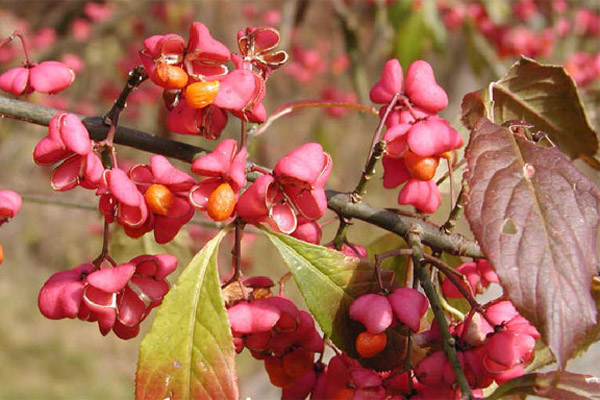
Poisonous berries picture, photo - euonymus
Privet (Wolfberry berries)
Privet is a genus of rather thermophilic shrubs of the olive family. Privet is a deciduous shrub up to 5 meters.
The leaves are simple, opposite. The inflorescences are white, similar to lilac flowers, also collected in panicles.
The fruit is a black berry. Privet blooms in May and July, after the appearance of leaves on it. Privet
The berries are poisonous, ripen in September and October and do not fall for a long time.
Spread of Privet
On the territory of the former USSR, primrose is found in its natural form. The aura of its distribution is the south-western part of Russia, the Caucasus, Ukraine and Moldova.
Poisonous parts of privet
Poisonous leaves and berries of the plant. The leaves are unlikely to be eaten, but the berries are quite similar to bird cherry.
Symptoms of Birchucine poisoning
After eating poisonous berries of privet after 1-2 hours diarrhea, colic, weakness, loss of coordination, convulsions occur, in severe cases death is possible.
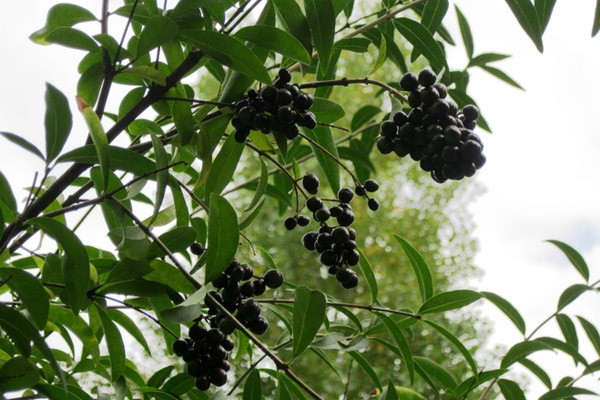
Poisonous berries picture, photo - privet
Elderberry herb (stinky)
Elderberry is an herbaceous perennial of the honeysuckle family with an unpleasant odor, with a thick creeping rhizome, thick, grooved (sometimes sparsely pubescent) stem 60-170 cm high.
Leaves with stipules, large (17-25 cm), pinnate of 7-11 pointed leaves, pubescent along the veins.
The elderberry inflorescence is an umbrella-shaped panicle. The flowers are small, inconspicuous, white or reddish. Elderberry blossoms bloom in May - June.
The fruits of the elderberry are black, small, berry-shaped drupes with 3-4 seeds and red juice. The elder is herbaceous in August - September.
Elderberry Herbal Spread
Common elderberry is distributed in southern Russia in the foothills and mountains, along forest edges and subalpine meadows. Often found as a weed.
Poisonous parts of the elderberry herb
Leaves, flowers, and elderberry are poisonous. Particularly poisonous unripe elderberry berries.
Symptoms of Elderberry Herbal Poisoning
The main symptoms of poisoning with poisonous elderberry berries are dizziness, headache, weakness, sore throat, abdominal pain, nausea, vomiting. Characteristic staining of the mucous membranes is blue due to the accumulation of oxyhemoglobin in the venous blood. Tachycardia is replaced in late stages of bradycardia. There is shortness of breath with a delay on the exhale, seizures are possible. Death comes from respiratory arrest on the background of acute heart failure.

Poisonous berries picture, photo - elderberry
Wolfberry, Daphne
Daphne - a low shrub is popularly called wolf's bast or wolfberry. In April, Daphne twigs are a meter and a half tall, almost entirely covered with bunches of bright pink flowers, very similar to the color of lilacs. From flowering plants spread a gentle peculiar aroma. Daphne leaves are narrow, dark green. Poisonous berries - oval, first green, then red, ripen in late July-August.
Wolfepodnik Spread
The wolves grow in the north of the European part of Russia, in Western and Eastern Siberia, in the Caucasus. Prefers coniferous and mixed forests. It is found in deciduous forests.
The poisonous parts of the wolfhorn
Daphne flowers are poisonous. Inhalation of daphne pollen is observed irritation of the mucous membranes of the nose and respiratory tract. Not only flowers are poisonous, but the whole plant. No wonder one of the names of Daphne - wolf cub deadly.
The bark of the wolf's bark is unusually bitter in taste and, if it gets into the mouth, causes a burning sensation and scratching. Subsequently, blisters and ulcers form on the mucous membranes. The touch of the wet bark of daphne, wolfgrass to the skin can lead to the formation of ulcers.
No less stinging juice in the leaves and poisonous berries wolf bast. Extremely dangerous to get juice wolfman's eyes. This threatens to form difficult-to-seize expressions of the cornea.
Symptoms of Wolf Bone Poisoning
After eating poisonous berries, there is a burning sensation in the mouth, pain in the stomach, nausea, vomiting, weakness, and convulsions are possible. But the wolf's bast contains not only mezerein, which is very irritating to the skin and mucous membranes, but also other poisonous substances, in particular, several types of coumarins that cause increased bleeding.
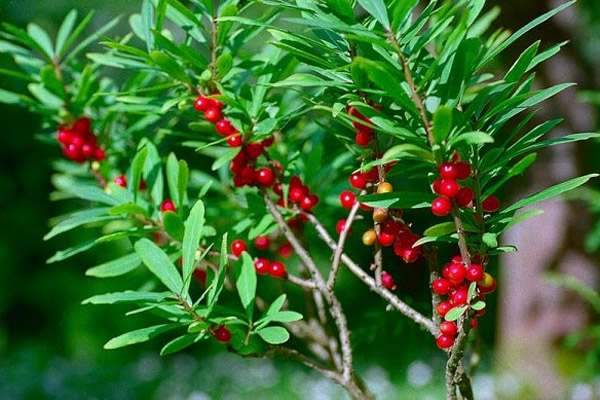
Poisonous berries picture, photo - wolfberry
Voronets spiky black or Akteya spiky
Cone-shaped Voronet is a perennial poisonous herbaceous plant up to 80 cm high, with a thin branched stem, with large, on long petioles, twice and triply pinnate leaves. The edges of the leaves are large-toothed.
The flowers are white or cream, small, gathered in a fluffy panicle.
The berries are first green, when ripe, black, glossy, large, oval-cylindrical with a clearly visible perianth trail. Berries are collected in a brush.
Spread of Black Spiky Voronove
Voronove spiky black grows in the European part of Russia, in the Caucasus, in Western Siberia, in the Altai, but is quite rare. Prefers shady wet places in deciduous, coniferous and mixed forests. Usually grows in thickets of bushes and trees. Voronove spiky black does not like open spaces. It blooms in May and June, the berries ripen in July and August.
Poisonous parts of the Voronitsa spiky
The whole plant is very poisonous. Especially poisonous berries of black spiky black.
Symptoms of poisoning Voronove spiky
The sap of the plant is irritating to the human skin, up to the formation of blisters. And even a small amount of poisonous berry pulp is enough to cause a strong disorder of the gastrointestinal tract.
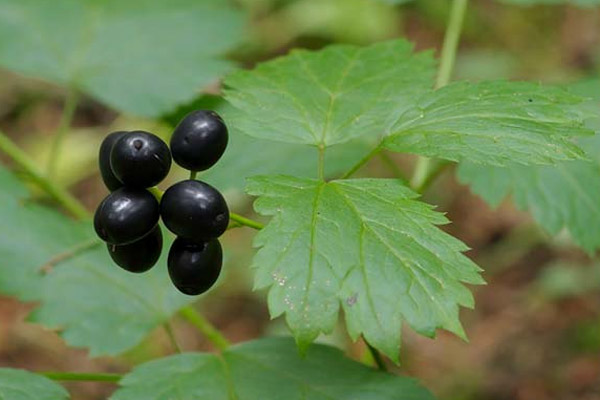
Poisonous berries picture, photo - black cohosh
Red Voronove (red; spiky red)
Voronovets kornoplodny - perennial herb. Stems thin, up to 70 cm.
The leaves are usually pinnate, jagged at the edges. The appearance of the black coronet Voronet is very similar to the black crowed, but differs from it primarily in the color of the fruit, a few smaller berries, as well as in the lighter color of the leaves.
The flowers are small, white, gathered in a vertical brush-whisk.
The berries of the black-headed coronus are uvlodenno-oval, medium-sized, green at first, whiten as they ripen and then turn red. Located on a vertical brush.
The spread of the black coronet
Voronet Krasnoplodny grows in coniferous and mixed forests in the Far East, in Siberia and in the north of the European part of Russia.
Poisonous portions
All parts of the plant are poisonous. The most toxic are the berries of the black Voronet. Eating only two poisonous berries for a child can end in tragedy. But the accidental poisoning of the berries of the black coronet is hardly possible, because the plant has an unpleasant smell, and the berries are very bitter.
Symptoms of poisoning
Symptoms of poisoning with the berries of black coronet - nausea, dizziness, increased heart rate, severe upset gastrointestinal tract.

Poisonous berries picture, photo - Voronet red
Raven eye
Crow's eye is a perennial plant of a very characteristic look. A short stalk framed in a sprawling, usually four (rarely, as in the photo, five) wide leaves, ends with a single nondescript greenish flower that blooms in July and June. Then the crow's eye turns the flower into one berry, blackening to autumn. The crow's eye is also known under the name of cross-grass.
Raven Eye Spread
A crow's eye grows in shady, wet areas of coniferous, deciduous and mixed forests throughout Russia’s temperate zone from Europe to the Far East. Crow's eye is considered a medicinal plant, but it is better not to assemble and use it alone, as a crow's eye is a poisonous plant.
Poisonous Raven Eye parts
Crow's berry, like other parts of the plant, is poisonous. The plant contains saponins and cardiac glycosides.
Symptoms of Raven Eye Poisoning
Poisoning with poisonous berries or other parts of the black eye causes irritation of the gastrointestinal tract, diarrhea, nausea, vomiting, a sharp drop in heart rate to 60-40 or less contractions per minute, heart rhythm disturbances, ventricular flutter and cardiac arrest.

Poisonous berries picture, photo - Crow's eye
Lily of the valley
Spread of Lily of the Valley
Lily of the valley grows mainly in damp shady places, in forest areas, in oak forests, in floodplain forests.
Poisonous parts of lily of the valley
The whole plant of the lily of the valley is poisonous. Lily of the valley berries are especially poisonous. Beautiful red berries are poisonous and they can not be plucked and even more so to eat.
Symptoms of Lily of the Valley
The most characteristic signs of poisoning by poisonous lily-of-the-valley berries are headache, tinnitus, a rare pulse, constriction of the pupils. Seizures are possible.

Poisonous berries picture, photo - Lily of the valley
First aid for poisoning berries
- Never pick or try berries that you do not know.
- If you come to the forest with a child, then for a minute do not leave him unattended. Watch what kind of berries he eats.
- If you come to an unknown area and nature is not quite familiar to you there, be sure to inquire with the locals, read the literature, browse the Internet sites and find out what poisonous plants are typical for this area.
- Poisonous berries are really dangerous only for those who do not know them by sight.
If symptoms of poisoning occur, such as fever, diarrhea, vomiting, seizures, etc., seek medical attention immediately. While the doctor will go to you, do not sit with folded arms. After all, sometimes the arrival of an ambulance can take more than one hour.
Most first aid in poisoning with poisonous berries is to stimulate the gagging urge - this procedure will release the stomach from the poisonous contents. To do this, the victim should be given 2-4 glasses of water (it can add activated carbon - 2 tablespoons per 500 ml, salt - 1 tsp per 500 ml or potassium permanganate). When poisoning with poisonous berries, the procedure will have to be carried out several times. From medicines it is recommended to give the patient activated carbon, tannin, as well as any laxative and heart remedy. If you have cramps, you will have to use chloral hydrate. If there is no first-aid kit, you can give the patient black rusks, a solution of starch or milk. It does not hurt to also make an enema (if there is such an opportunity). A victim of poisoning with poisonous berries must be wrapped up warmly and taken to a doctor.


